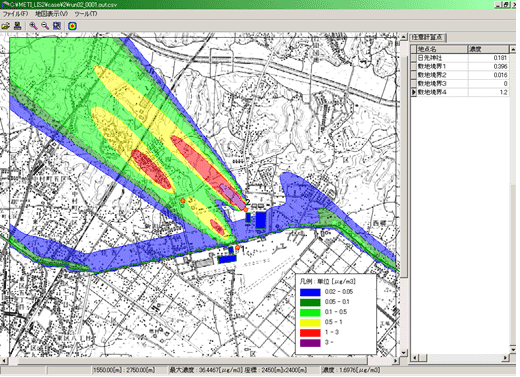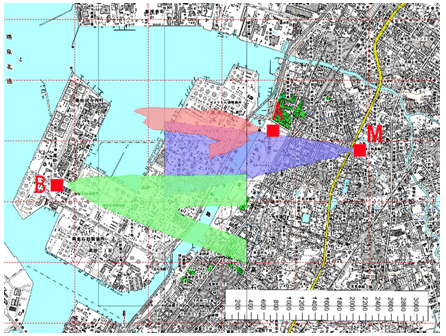INTRODUCTION
Atmospheric Environment Team (AET), led by Dr. Hiroshi Yoshikado, consists of four members. In October 2004, the AET was re-organized, and the Exposure Modeling Team (EMT) was separated from the AET, but they have been collaborating to carry out the primary missions described below.
Many chemical substances that may cause adverse human health effects are released into the atmosphere, and therefore, one of the main objectives of the CRM is to investigate their behaviors in the atmosphere and to develop methodologies and techniques for estimation and evaluation of chemical concentrations in the ambient air and their human exposure risks. The AET plays the main part of this research and development.
Major research subjects of the team are as follows:
1) Techniques to search for emission sources and to estimate accurate emission amount of chemical substances;
2) Modeling of atmospheric diffusion, transport and formation/transformation process of chemical substances;
3) Evaluation of human exposure to the chemical substances from the concentrations obtained by the above technique and tools;
4) Emission control strategies based on the assessment of chemical dispersion/exposure levels; and
5) Risk assessment of chemical substances mainly transported and exposed via the atmosphere.
It is particularly important to use accurate models to simulate the chemical dispersion in the atmosphere and resultant concentrations at arbitrary locations. The AET plans to provide the results of research for public use in formats such as user-friendly software for PCs or a guideline manual.
DISPERSION MODELS OPEN TO PUBLIC USE
The AET has developed two dispersion models of different types, both of which are currently available in the form of PC software with advanced graphic user interfaces. English versions for these models are also available.
The first type is AIST-ADMER (Atmospheric Dispersion Model for Exposure and Risk assessment), which can be applied to the distribution of pollutants in such wide regions as the Kanto or Kinki district in monthly to annual average. The ADMER is currently maintained and improved by the EMT (see Introduction to the EMT).
Another type of dispersion model is METI-LIS (Ministry of Economy, Trade and Industry - Low-rise Industrial Source Dispersion Model), the model domain of which is typically 10 x 10 km around specific point sources.
Measures have been taken for many years for environmental control of such air pollutants including sulfur dioxide and nitrogen oxides mainly emitted from high stacks. In contrast, most HAPs (hazardous air pollutants) are emitted from relatively low sources, and therefore their dispersion is affected in the first stage by nearby buildings or other ground-based objects, tending to cause a downward motion called downdraft.
The METI-LIS puts special importance to expressing the effect of downdraft when building data around the sources are given, while it gives solutions of simple Gaussian plume and puff formula for elevated sources. Essential input data are emission rate and other emission conditions such as location, height, gas volume and temperature, and meteorological factors at every hour during the averaging period. Users can select an optional mode of average simulations for either short-term or long-term. For most locations in Japan, the AMeDAS data supported by the Japan Meteorological Agency (provided in CD every year) are applicable to the latter case.
The METI-LIS and its user’s manual can be freely downloaded from the internet site (there is a link on the CRM homepage --> “Exposure Assessment Models”). It is expected that industries, which release pollutants, governmental bodies, which guide or instruct industries, citizens and educators share this tool for risk communication.

Fig. 1 An example of displayed result of the METI-LIS in case of three point sources and one line source.
Here, a short history of the METI-LIS is mentioned. As a Gaussian dispersion model, which incorporates the downdraft effect, the ISC model authorized by the US Environmental Protection Agency (EPA) has been widely used. The Japan Ministry of Economy, Trade and Industry (METI) planned to develop an improved downdraft model based on the ISC model in 1996, when HAPs were newly taken into the Air Pollution Prevention Act in Japan. A series of wind tunnel and field experiments were carried out for the modeling under the funding of the METI, and a pilot version of the model came out in 2001 as the METI-LIS.
The AET contributed to the development of the METI-LIS from the beginning, and took the initiative in developing the present improved version (Ver.2) with more reasonable algorithm, additional functions and further user-friendly handling tools.
DEVELOPMENT OF NEW MODELS AND METHODS
Three kind of modeling actions are presently proceeding:
1) An inverse analysis system seeking emission sources of HAPs based on measured ambient concentrations is under construction since 2005, based on the METI-LIS model algorithm. Due to diverse volumes and qualities of measured data, the system will be composed gradually with adding various examples.

Fig. 2 An example of inverse analysis seeking emission sources. Points M, A, and B are monitoring sites of acrylonitrile concentrations, and the colored areas possible source zones obtained from the system.
2) An exposure model for roadside areas to improve the estimate of exposure to automobile exhaust chemical substances has been completed in 2006, while the estimating scheme of roadside population is not sufficiently verified.
3) A next-generation regional-scale transport model system is investigated for risk assessment of chemically active air pollutants such as ozone and aldehydes, to which the ADMER cannot be applied, mainly by the
EMT.
COMPILATION OF DETAILED RISK ASSESSMENT DOCUMENTS
The models and methods developed by the AET have been employed in the risk assessments of specific chemical substances developed by CRM. The AET itself completed the risk assessments of 1,3-butadiene and dichloromethane, and is presently preparing release of those documents for tetrachloroethylene, benzene and acrylonitrile.